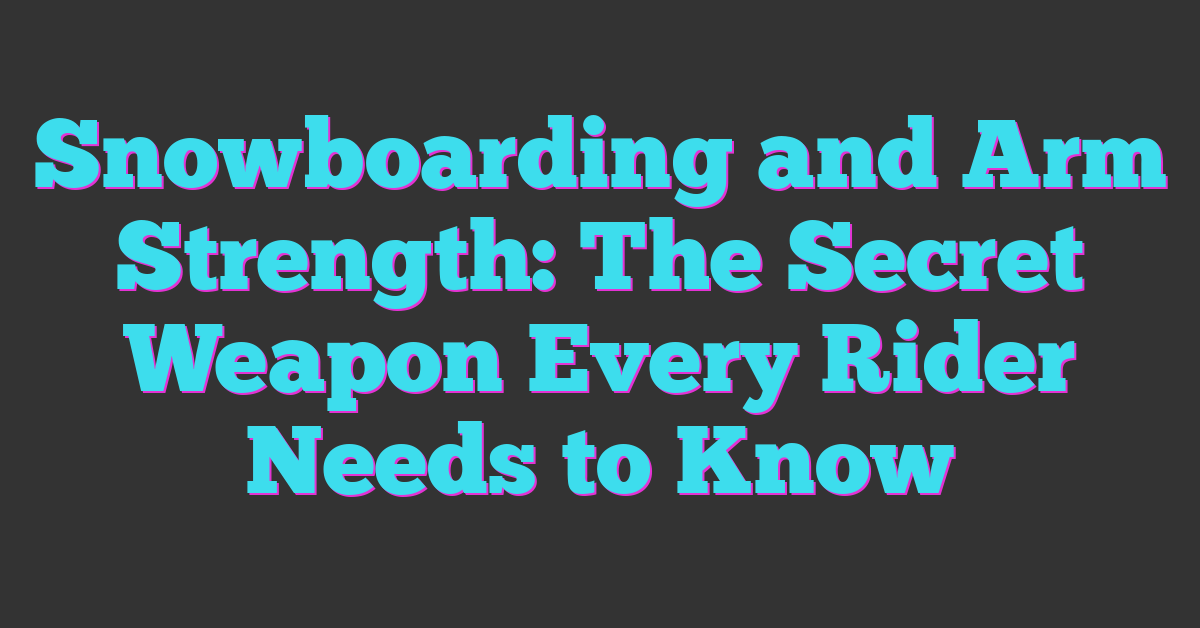Snowboarding is an incredible way to enjoy the winter outdoors but dealing with numbness can really put a damper on your day. That tingling or loss of feeling in your hands and feet isn’t just uncomfortable—it can affect your balance and control on the board.

Luckily, you don’t have to accept numbness as part of the ride. With a few simple tips and tricks, you can keep your fingers and toes warm and responsive so you stay comfortable and in control. Whether you’re a beginner or a seasoned rider, learning how to prevent numbness will make your time on the slopes way more enjoyable.
Understanding Snowboarding Numbness
You know how quickly cold can creep in during a day on the slopes, stealing sensation from your fingers and toes. Snowboarding numbness happens more often than you think, but grasping what causes it lets you tackle it head-on.
Common Causes of Numbness While Snowboarding
- Cold Exposure: Prolonged contact with snow and freezing air slows blood flow to extremities, causing that biting numbness in hands and feet.
- Improper Gear Fit: Boots or gloves that are too tight restrict circulation, making your fingers and toes feel pins and needles or go completely numb.
- Poor Circulation: Underlying conditions or simply sitting or standing too long on cold surfaces can worsen blood flow, leading to numbness.
- Nerve Compression: Stance and pressure from boots can compress nerves around the feet or hands, resulting in localized numbness.
- Wet Clothing: Moisture causes heat loss faster, chilling nerves and skin, increasing the numbness risk.
Symptoms to Watch For
- Tingling Sensation: The first warning sign usually feels like pins and needles or a slight prickling in your fingers or toes.
- Loss of Sensation: When tingling fades, you may notice complete numbness, making it hard to sense cold or pressure.
- Color Changes: Pale or bluish skin signals restricted blood flow and requires immediate attention.
- Cold, Clammy Skin: This indicates your extremities are losing heat rapidly.
- Difficulty Moving Fingers or Toes: Stiffness or clumsiness often follows numbness, hampering your ability to grip edges or balance properly.
Recognizing these causes and symptoms early puts you in control of your comfort and performance on every run.
Proper Gear and Equipment
Selecting gear designed to keep you warm and dry plays a key role in preventing numbness on the slopes. Your choices in gloves, socks, boots, and layers influence circulation and comfort, ensuring your hands and feet stay responsive throughout your ride.
Choosing the Right Gloves and Socks
Start with insulated, waterproof gloves that provide both warmth and dexterity. Gloves with breathable membranes like Gore-Tex keep moisture out but allow sweat to evaporate, reducing dampness that causes coldness. Select gloves with articulated fingers and adjustable wrist closures for a snug fit that avoids nerve compression.
Opt for socks made of moisture-wicking materials such as merino wool or technical synthetics to maintain dryness. Avoid cotton socks, which trap moisture and promote coldness. Choose socks offering cushioning in pressure points and size them correctly to prevent circulation restriction or bunching inside boots.
Importance of Well-Fitted Boots
Wear boots that fit securely without tight spots that impede blood flow. A boot with proper arch support and adjustable liner helps stabilize your foot and prevents numbness caused by pressure on nerves. Custom footbeds or heat-moldable liners enhance fit and comfort for extended rides.
Check that your boots do not pinch your toes or cause excessive pressure around ankles. Properly tightened boots allow for good circulation and prevent cold-induced numbness while maintaining control of your board.
Layering for Warmth and Circulation
Dress in layers using breathable, insulating fabrics to regulate body temperature and protect extremities. Start with a moisture-wicking base layer that moves sweat away from your skin. Add a mid-layer of fleece or synthetic insulation to retain heat without bulk.
Wear an outer shell that shields against wind and moisture to prevent heat loss. Avoid overly bulky layers that restrict movement or circulation. Layering enables quick adjustments based on activity level and weather, keeping blood flowing freely to your hands and feet.
Techniques to Reduce Numbness
You can prevent numbness while snowboarding by focusing on circulation, warming your body, and managing rest and hydration. These techniques keep your fingers and toes responsive throughout your rides.
Maintaining Good Blood Circulation
Start each day by wearing gear that fits snugly without constricting. Tight gloves or boots restrict blood flow and cause numbness. Move your fingers and toes frequently on the slopes to keep blood pumping. Wiggle your digits or gently flex your ankles during stops. Elevate your hands if they feel cold when taking breaks to encourage circulation. Avoid crossing your arms or legs for long periods since this compresses nerves and reduces blood flow.
Effective Warm-Up Exercises
Begin your day with dynamic stretches that focus on your hands, wrists, feet, and ankles. Perform wrist circles, finger spreads, ankle rolls, and toe flexes for at least five minutes before hitting the snow. Warm muscles and joints improve blood flow and nerve sensitivity. Practice light jogging or jumping jacks to increase overall circulation. If you feel numbness returning, stop for a quick warm-up to restore warmth and sensation.
Taking Breaks and Staying Hydrated
Schedule regular breaks during your snowboarding sessions to warm your extremities and relax tense muscles. Remove gloves and boots briefly if the environment allows, helping reset blood flow. Drink at least 16 ounces of water every hour to prevent dehydration, which worsens circulation issues. Opt for warm beverages like herbal tea during breaks to raise your core temperature gently. Avoid alcohol since it dilates blood vessels but reduces your body’s ability to retain heat effectively.
When to Seek Medical Advice
Knowing when numbness signals a serious issue protects your passion for snowboarding and keeps you riding safely. Pay close attention to your body’s alerts and act promptly if symptoms worsen or persist.
Recognizing Serious Symptoms
Watch for numbness that lasts beyond your time on the slopes or returns frequently despite taking precautions. Sharp pain, muscle weakness, or loss of coordination in your hands or feet need urgent attention. Noticeable color changes like persistent paleness, bluish or red tint in your fingers or toes also indicate circulatory problems requiring medical evaluation. If tingling escalates to burning sensations or if you find it difficult to grip or balance, your nerves might be compromised.
Preventing Long-Term Nerve Damage
Ignoring persistent numbness increases the risk of lasting nerve damage that can affect your performance and enjoyment. Seek professional advice if your symptoms don’t improve with warmth and rest. Early diagnosis can prevent conditions like frostbite or neuropathy from developing. Follow prescribed treatments and adjust your snowboarding gear and habits to protect your extremities for many seasons to come.
Conclusion
Keeping numbness at bay is all about staying proactive and listening to your body. With the right gear, smart layering, and simple habits like moving your fingers and toes regularly, you can enjoy every run without discomfort holding you back.
Remember, your comfort directly impacts your control and confidence on the board. So, take those breaks, stay hydrated, and don’t ignore any persistent symptoms that feel off. When you prioritize your warmth and circulation, you’re setting yourself up for a more fun and safer snowboarding experience.
















